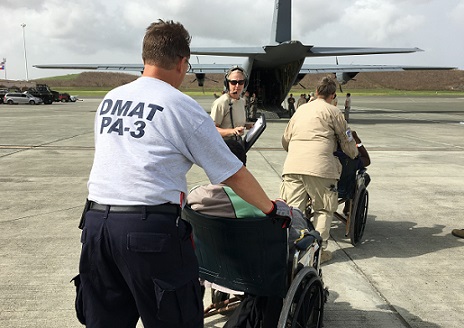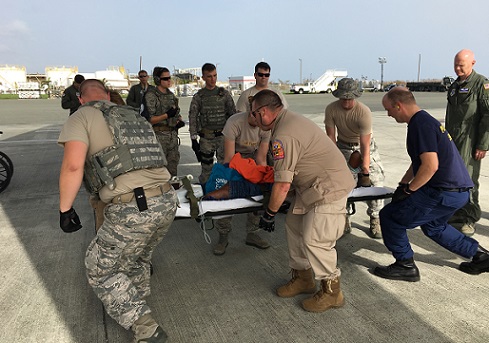TAMPA, Fla. (WFLA) – Not long after the sun comes up, a flight crew preps an Air Force C130-J for a long flight.

The aircraft is a cargo plane, primarily designed to fly equipment and people into and out of war zones.
This mission will take a team of critical care medical staff into an area attacked by Hurricane Maria.
“We’ll be able to provide close to an ICU level of medical care, as close as you could during transport,” said Lt. Colonel Sean MacDermott with the 11th Medical Group from Joint Base Andrews.
MacDermott leads a team of nurses and medical staff on a mission to evacuate patients in dire need of urgent medical care.
“When we arrive in St. Croix if there are any ICU level patients, critical care patients, we are the ones who will be responsible for safely transporting those patients back to the States,” said MacDermott.
The team has to be flexible. As they depart they are expecting one patient in St. Croix, and when they land they may be evacuating more than 50.
“The information that we are given prior to starting the mission can change pretty dramatically on route,” said MacDermott.

Staff Sergeant Nichole Kilinc with the 43rd Aeromedical Evacuation Squadron from Pope Army Airfield in North Carolina. She is part of the team that will provide the critical level of medical care to each patient during the flight.
Kilinc and her team have to prepare for a variety of patients with many different conditions.
“We don’t really know what to expect. They gave us one patient when we were going down there, but it could be 40 patients when we land, it could be 20,” said Kilinc.
When the team arrives in St. Croix, they pick up patients at the airport in a room that’s normally used by cruise ship passengers.
Colonel Tami Rougeau, who is assigned to SG3 health care operations, is the director of patient staging, meaning she’s in charge of coordinating all of the patients’ movement that happens off of St. Croix.
Colonel Rougeau works with the local hospitals to determine who needs to be evacuated to the United States.
“Some of them have long-term illnesses, some of them were patients in the hospital prior to the storm coming through. Some of them have become ill or were injured in the storm and some after the storm,” said Rougeau.

On the ground in St. Croix are staff from FEMA and the Department of Health and Human Services, working with the Air Force to evacuate the patients.
“I’ve been to Katrina, I’ve been to Haiti and now this and this is some of the most challenging we’ve ever had. It’s not as the conditions were in Haiti, it’s just much more extensive and widespread. An earthquake was kind of isolated to one area in Haiti and this storm had no mercy. It went across multiple islands and people had evacuated from a previous storm, got hit here by a second storm,” said Russell Bieniek with National Disaster Medical System.
Bieniek says the evacuation missions are saving lives.
“They are beyond important. They are critical and essential. If they did not the people you see behind us would not be here and probably tomorrow or the next day,” said Bieniek.
The patients are loaded onto the C130, some are delivered to the plane in wheelchairs, some have to be carried on gurneys.
They will be taken care of during the five-hour flight to Dobbins Air Force Base in Atlanta and from there they will be sent to several local hospitals.
The mission lasts more than 15 hours. Flight crew and medics can end their day knowing they have saved lives.
Follow Jeff Patterson on Facebook
- Two Pinellas 7-Eleven stores robbed within minutes of each other
- Florida boy, 4, chokes to death on meatball at school
- Man found dead, floating in water off Gulfport
- Sarasota PD seeks help finding woman who texted about medical emergency
- NCAA coaches among 10 arrested by FBI in fraud and corruption probe
- Citgo accused of selling crack, meth pipes in Trilby
- Tampa Bay area McDonald’s to thank first responders with free meals on Sept. 27
- Body found near intersection in Tampa may be identified by tattoos
- Baby left on side of Oklahoma freeway in car seat with cash






